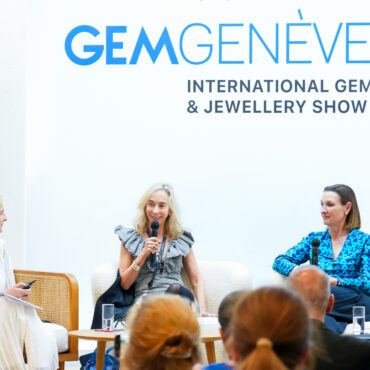At the GemGenève May 2025 edition, colour took centre stage. In a spirited conversation moderated by jewellery journalist and content creator Katerina Perez, three experts — Carl-Philip Arnoldi, the future successor of the German cutting house HC Arnoldi, Constantin Wild, president of Constantin Wild GmbH & Co.KG, and David Nassi, third-generation gem merchant and lapidary artist from New York — explored the growing fascination with rare coloured gemstones. Their dialogue dismantled outdated definitions, charted shifts in taste and value, and celebrated the rediscovery of treasures once dismissed as “semi-precious.”
From “Semi-Precious” to Precious
Perez set the tone by sharing a personal anecdote. In a London jeweller’s office, she had once heard a colleague casually describe a fine rubellite tourmaline as “semi-precious.” The term, she explained, has long been used to rank gems, but it fails to capture their rarity or beauty. “How can you call a gemstone semi-precious,” she asked, “when it commands thousands at auction, when it is finite, when it comes from the Earth itself?” For her, the distinction is meaningless: every natural gemstone is precious. If the prefix “semi” is to apply to anything, she added pointedly, it should apply to synthetic materials.
This opening challenge framed the discussion. The panellists agreed that what was once considered secondary now commands its rightful place in the spotlight.
Rediscovering a Spectrum
Constantin Wild highlighted the extraordinary diversity of nature’s palette. Even within familiar mineral groups, he noted, there is an entire spectrum waiting to be explored. Corundum is not limited to rubies and blue sapphires, but extends to yellows, greens, purples, oranges, and delicate pinks. Beryl is not only emerald and aquamarine, but also golden heliodor, pastel morganite, and the vanishingly rare red beryl. Tourmaline, for him, is the most versatile: its colours range from the neon glow of Paraíba blue to lagoon, mint, rubellite, canary yellow, and even colourless varieties. Garnet, too, deserves recognition — long relegated to “ordinary,” it reveals an astonishing range of mandarins, greens, and even colour-changing stones. And amethyst, he added with conviction, remains deeply undervalued despite its beauty.
For David Nassi, this abundance of colour represents more than mineralogical variety: it is about human connection. “Colour is self-expression,” he explained. “People choose what resonates with them. Intense pinks, purples, greens, blues — they are not just stones, they are part of how people express themselves today.”
The Changing Face of the Market
The conversation then turned to the forces driving this rise of colour. Wild observed that women, more than ever before, are buying jewellery for themselves. “In the old days,” he reflected, “a man bought jewellery to show status. The bigger the white stone, the more important he appeared. But today, women choose for themselves — and they choose colour.”
Perez added that jewellery has shifted from being a rigid marker of status to becoming an extension of mood and fashion. “One day you feel like ruby,” she said, “the next day pink, or yellow. It’s about freedom to explore the whole palette.”
This shift has implications for design. Tired of relying only on ruby, sapphire, and emerald, jewellers increasingly turn to garnet, tourmaline, spinel, or amethyst to create fresh palettes. On the red carpet and in contemporary collections, coloured stones no longer play supporting roles: they are protagonists.
Rarity and Desire
Yet the Earth cannot be forced to deliver stones on demand. Wild reminded the audience that supply is finite. “You can’t ask the Earth to produce a pink gemstone because Pantone announces it as the colour of the year,” he said. The example of Paraíba tourmaline proves the point. By the time its electric blue became the most coveted colour in the market, the Brazilian mines were almost exhausted. Prices skyrocketed from hundreds to hundreds of thousands of dollars per carat for the finest stones.
Nassi noted that rarity fuels desire. “Once collectors know something is rare, they must have it,” he said. “Rarity and beauty together create urgency — and that is when prices soar.” Arnoldi agreed, pointing to the case of mandarin garnet, which evolved from being overlooked to being celebrated once high jewellers embraced it.
Knowledge, Trust, and Treatments
The panel also addressed the growing importance of transparency and education. Traceability — knowing a stone’s origin and the conditions of its mining — increasingly influences buying decisions. Treatments, too, are under scrutiny. While the vast majority of sapphires are heated, Wild insisted that such practices should not automatically be seen negatively. “Low-temperature heating simply awakens the colour already in the stone,” he explained. “What matters most is beauty.”
Consumers, however, want clarity. Perez observed that social media has opened gem knowledge to a broader audience, but with it comes misinformation. “Alongside valuable insights, you find misleading claims of rarity or value,” she warned. Wild added that in this context, trusted voices are essential, and he singled Perez herself out for praise as an influencer who educates with integrity.
The role of trust also underpinned Arnoldi’s reflections on the digital marketplace. His platform, GemHype, faced scepticism at launch: could gemstones really be sold online, without the tactile experience of handling them? By combining high-quality videos, transparent information, and consignments, trust was built, and today the platform thrives. It was a telling example of how even the most traditional of trades can adapt to the digital age.
Revivals and Rediscoveries
The panellists delighted in noting how forgotten stones are returning to prominence. Black opal, once clouded by superstition, is now celebrated for its play of colour. Spinel, long mistaken for a synthetic material, is enjoying a renaissance. Garnet is being rediscovered in all its brilliance. Tanzanite, too, is surprising collectors not only in its famous blue, but in pinks and greens once dismissed as “off-colours.”
An audience member asked about alexandrite, and the panel smiled at the mention of this chameleon stone. “Emerald by day, ruby by night,” Nassi said, recalling its Russian origins and new deposits in Brazil, India, and East Africa. It was, he suggested, the perfect example of how gems embody natural magic.
Fashion, Fame, and Feeling
When asked whether fashion trends such as Pantone’s yearly colour influence the gem trade, the panel laughed. “Impossible,” said Wild. “Nature’s palette is infinite — it cannot be reduced to a single chart.” Still, celebrity appearances can have powerful effects. When Meghan Markle wore a large aquamarine, demand for the stone spiked across Asia almost overnight.
Beyond fashion, gems also evoke emotional resonance. One question from the audience raised the idea of gemstone therapy. Nassi recalled his father’s fascination with the subject, noting how certain colours calm, energise, or uplift. “These are the Earth’s oldest creations,” he said. “It is natural to feel they hold some kind of power.”
A Bright Future for Colour
As the discussion drew to a close, the panellists reflected on what might come next. Wild spoke of his love for imperial topaz, with its sunset hues, and hoped to see it more widely appreciated. Arnoldi emphasised the untapped diversity of garnet, while Nassi pointed out that the rainbow itself was the true treasure — infinite, varied, and ever inspiring.
Perez concluded with a sentiment that captured the spirit of the session: “Whatever comes from the Earth is precious.”
Once relegated to the margins as “semi-precious,” coloured gemstones now shine at the heart of design, collecting, and self-expression. The rise of colour is not a passing fashion, but a celebration of life itself — vibrant, individual, and enduring.
Speakers:
Moderator: Katerina Perez (Journalist, Content creator)
Carl-Philip Arnoldi (Gem cutter and future successor of HC Arnoldi)
Constantin Wild (President of Constantin Wild GmbH & Co.KG)
David Nassi (President of 100% Natural Ltd., 3rd generation gem merchant, lapidary artist)




